Work on the construction and cleaning of the well, as a rule, is carried out manually. However, in some cases, masters prefer to use special devices- drainage pumps, which allow not only to quickly pump out water, but also to remove silt with small pebbles.
Which pump is suitable
Not all pumps are suitable for An ordinary flow-through (such as "Brook") will not be able to cope with this work. First of all, its performance will not allow you to quickly scoop out water. And secondly, its filter will quickly become clogged with sediment from the bottom. Therefore, it is drainage pumps that are selected for cleaning wells. They are able to pump water with a suspension of sand and even small stones. Such pumps are used to pump water from basements, cesspools, etc. When buying a pump, it is important to pay attention to such indicators as productivity (the number of cubic meters of water that it pumps out per hour) and also maximum size particles that he can overtake through himself. Since the pump will be rarely used (the well is cleaned every few years), you can choose equipment with a plastic case. It is cheaper and does not rust when it is idle.
Pump cleaning features
The drainage pump must be lowered to the very bottom of the well - into the silt. Such equipment usually turns on automatically when immersed in water. The pump will begin to pump out water and dirt. Please note that the greater the lifting depth and the length of the hose, the lower the performance of the pumping equipment.
It is believed that the pump can completely pump out the sludge. However, we still recommend that after its work you go down and carry out manual disinfection of the well. In any case, it will be required to carry out it in order to remove algae from the walls of the well. Also, only manually you can replace the stones in the bottom filter. Going down to the bottom of the well, do not forget that poisonous gases can accumulate there. So do not work without a partner and a special protective mask.
Alexei
27.01.2015 Pumping stationsThere is a well in many household plots. It is a simple and at the same time an effective source of water in those places where there is no centralized water supply, and the technology of its construction in our area has been developed for centuries.
But over time, the wells fall into disrepair, and the water in them ceases to be crystal clear.
To prevent this from happening, they, like any technical structure, must be cleaned regularly. Such work can be carried out different methods. One of them is cleaning the well with a pump. Freed from sand, silt or quicksand, your source will again fill with transparent clean water. And its quality will return to the previous indicator.
When to Clean a Well
It is not possible to determine the specific timeframe for carrying out maintenance work in advance. The periods between cleanings can be different in duration and depend on many different factors. For example, important role a hydrobiological characteristic plays a role in the contamination of the well personal plot. It also depends on what materials were used in its arrangement.
Watch the video for what you need to clean:
In general, cleaning the well manually or with a drainage pump is carried out if:
- The water continues to be cloudy even after passing through the filter;
- An unpleasant odor came from the well;
- An oil film floats on the surface of the extracted liquid;
- The water level has dropped significantly.
It is clear that in all such cases it is impossible to delay the cleaning work. Dirty and foul-smelling moisture can pose a serious health risk to anyone who ingests it. And if the lack of financial opportunities does not allow to involve good specialists, then you can do it yourself. Installing a water drainage pump in the well will help to do this. How to do this, we will try to cover in this article.
Types of pumps and their scope
The main purpose of this equipment is pumping liquid. In wells, it is used when the degree of water pollution is not yet too significant. But in general, the scope of drainage pumps is very wide. They can be used in the following cases:
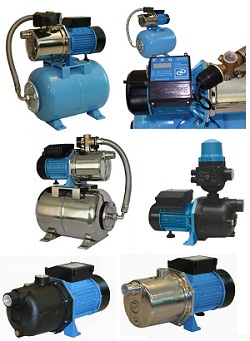
Currently, there are two types of drainage devices:
- Submersible;
- Surface.
The most popular and widely used by summer residents and owners of suburban housing are pumps of the first type, which in turn are divided into vibration and centrifugal. Each of them has advantages and some disadvantages. But all of them can be used to restore the normal functioning of the water source.
A drainage pump of any kind for a well is characterized by ease of operation, low cost, the ability to self-assembly and its replacement.
Features of submersible equipment
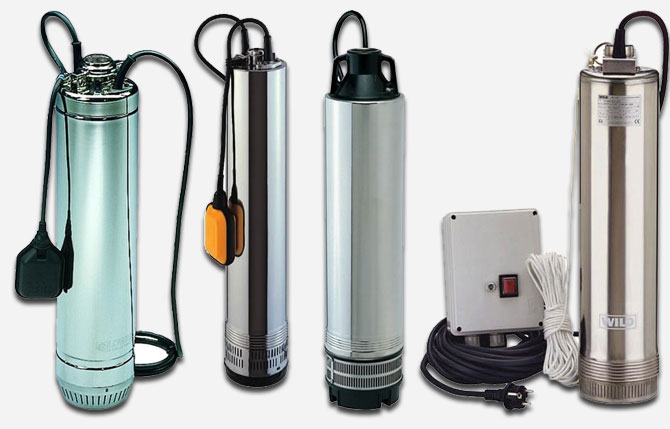
submersible pumps
The main advantages of these pumps are the following:
- Little weight;
- Long service life;
- Small dimensions;
- Versatility;
- High performance;
- They can work in automatic mode.
The disadvantages include the fact that the drainage water pump for the well cannot work from depths of more than 20 meters. Its effectiveness drops already at the level of 10 meters. And, of course, the water raised with it is not purified, so it can lead to contamination of the system into which it is supplied.
Features of surface pumps
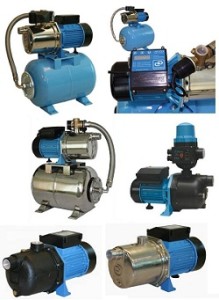 The advantages of this type of device include:
The advantages of this type of device include:
- The high power of the pressure of the pumped water, which makes it possible to transfer it to several tens of meters;
- Absence of breakdowns that are possible in submersible analogues when working in a liquid medium;
- Possibility of installation indoors without supplying the mains to the well;
- The equipment can work continuously.
A drainage pump of this type for a well also has disadvantages. In particular, it cannot be used to clean deep springs. It emits noise during operation, as a result of which placement in special technical rooms is required. The operation of the suction line requires certain skills and abilities.
Equipment installation
The installation of the pump is quite simple, but in order for it to work in the future without breakdowns and emergencies, the installation should be carried out adhering to certain rules.
When buying equipment, be sure to check the availability of all components and carefully read the attached instructions. Operation and specifications different models may differ significantly. Experts advise to pay attention to the limitations in the application.
Watch the video, cleaning steps:
Step-by-step instructions for installing a drainage pump look like this:
- First, the hose is connected to the pressure pipe, using the necessary connecting elements.
- In the presence of float switch a non-return valve must be installed on the pressure line.
- A device with a three-phase electric motor is checked for correct rotation. For this equipment is placed on a horizontal surface and immediately turned off after switching on. If the pump shaft turns clockwise, then everything is correct. Otherwise, the phases will have to be reversed.
- The pump is installed in a position in which the discharge pipe is directed upwards.
- The unit sinks to the bottom of the well.
When operating the equipment, safety precautions must be observed; in case of the slightest malfunction, it is necessary to turn off the power supply.
Proper operation and cleaning of the well
When choosing the required model, the instructions should be carefully studied also for the reason that some drainage pumping mechanisms can initially pump only clean water, without impurities. If heavily soiled, they will soon fail. Cleaning a silted well is only possible with a drainage pump that can handle the pumping of contaminated fluid with various impurities, including small fibers.
Routine work will be easier to carry out if. It is a mechanism that floats on the surface and, when the device reaches the bottom, turns it off. In its absence, the operation of the pump must be monitored to avoid overheating of the engine, which is above the water level.
Watch the video for some tips:
It is very important to properly configure the device for further trouble-free operation. good cleaning well water is possible only when creating swirls in it, which will destroy all existing deposits. To do this, do the following:
- Immerse the mechanism to a depth at a distance of not more than one meter from the bottom;
- We direct the outlet pipe back to the well, as a result of which the water will begin to move in a circular motion along the walls, destroying the deposits on them and at the very bottom;
- Periodically lift the device and clean its filter.
After a thorough cleaning of the well with a drainage pump, it can be left at the bottom in order to continue to maintain the purity of the water in the future. In this case, experts recommend cleaning the filters in it at least once every six months.
Overview of popular models
Domestic buyers are most in demand pumps of the following brands:
- Wilo Drain T. M. 32/7−10 m (Germany);
- Grundfos Unilift K.P.
- Karcher SDP 5000 (Germany);
- Makita PF1010 (Japan);
- Whirlwind DN-900 (Russia).
The popularity of products from Germany and Japan is due to their reliability and good performance. The casing of the Danish pump is made of of stainless steel and it, thanks to the presence of a vertical float switch, can operate in automatic mode.
The domestic unit has a power of 900 W and is capable of pumping very dirty water. Its cost is 2200 rubles, which is consistent with the declared quality.
Outcome
Drainage equipment is an indispensable thing in the household on any adjacent plot. With it, you can pump out water from the basement, when it is flooded, from the pond, when removing silt. And, of course, you can easily deal with any contamination of the well with it. We have already described how to do this above.
Well water will not always please you with its crystal clearness. Over time, it becomes dirty, cloudy, acquires an unpleasant odor, and becomes unusable. To avoid these problems, preventive cleaning of the well is carried out, and general cleaning should be done at least once a year. We will figure out how to clean it with our own hands, without resorting to the help of specialists.
Before you learn how to clean the well with your own hands and do it, you need to understand what causes water damage.
- Well silting. In this case, the water becomes cloudy and acquires a characteristic taste of silt. In the dishes after using such water, you can feel a slimy thin film. Severe haze can also be caused by deposits of sand and clay or depressurization of the joints between the rings.
- rusty water due to iron impurities. If such a liquid is poured into a glass, then, after standing, it will have a rusty sediment and plaque. The use of such water is highly discouraged. To solve the problem, use special filters to remove iron from the liquid.
- Oil film on the surface of the water can talk about the ingress of oil into the well. This can happen due to depressurization of the mine or careless use of the well.
- Bacterial contamination can be formed during stagnation due to infrequent use of the well. Accidental organic debris or animals and birds can also provoke this kind of pollution.
- The water turns green and blooms in the warm season due to the development of algae in it. sunlight promotes plant growth. So that the well does not turn into a swamp, it is necessary to close it.
- If an aspen bottom is installed at the bottom of the well, water can blacken and rot.
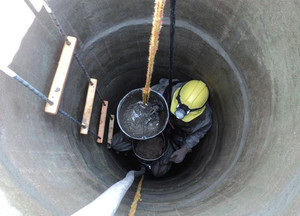 The well must be cleaned twice a year. last resort- at least once a year. But there are a number of signs, the appearance of which suggests that cleaning should be carried out immediately.
The well must be cleaned twice a year. last resort- at least once a year. But there are a number of signs, the appearance of which suggests that cleaning should be carried out immediately.
- The water level has dropped.
- The water turned cloudy.
- The water has acquired an unpleasant odor and taste.
- Deposits formed on the walls of the well.
- Debris fell into the well.
It is not necessary to wait for these signs to appear, cleaning should be done regularly. Best time for the procedure - the middle or end of spring, when the snow has melted and the level ground water dropped.
Cleaning technologies
Cleaning can be preventive and capital in nature. Prevention is carried out even if the water seems clean. To do this, dissolve a tablespoon of potassium permanganate in a bucket of water and pour it into the well. After 2-3 hours, it is necessary to pump out all the water. Major cleaning can be done in one of two ways:
- Do-it-yourself well cleaning.
- Cleaning with a mud pump.
Consider how to clean the well in the country in stages by each of the methods.
hands
Cleaning a well is a time-consuming and unsafe business. In order to thoroughly prepare for the procedure, check out the list of equipment that will definitely come in handy.
- Strong cable and rope for insurance.
- Stable ladder.
- Retaining platform for stairs.
- High rubber boots and a protective helmet.
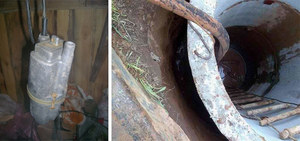 It is also worth thinking about security measures. Working alone is strongly discouraged. There must be someone nearby who can help. Before diving into the well, check for harmful gases inside. This is easy to do: drop a lit candle into the well. If it continues to burn, then there is enough oxygen. If not, then cleaning will have to be carried out in a gas mask.
It is also worth thinking about security measures. Working alone is strongly discouraged. There must be someone nearby who can help. Before diving into the well, check for harmful gases inside. This is easy to do: drop a lit candle into the well. If it continues to burn, then there is enough oxygen. If not, then cleaning will have to be carried out in a gas mask.
So, the first stage is preparatory. When the equipment is assembled and helpers are found, you can dive into the well shaft. The canopy can interfere, so it can be dismantled for a while.
First of all, it is necessary deflate maximum amount well fluids. You can do it with buckets, but it will be much faster to do it with a pump. A pump of even low power is suitable, the main thing is not to lower it too deep. It will not be possible to drain the mine completely anyway; in any case, liquid will remain at the bottom.
Then spend mechanical cleaning mine walls. Dirt is scraped off with brushes, scrapers, the walls are washed with clean water and a rag. All the dirt that you clean off will fall down, but this is not critical. Bottom silt and all other dirt will then be removed. For washing, do not use chemical and other household products. The well can only be washed with clean water.
After washing the walls, you need to check them for presence of cracks. If cracks are found, then it will be necessary to carry out repair work. Cracks and other damage can occur due to the displacement of the rings or the appearance of vegetation in the well. Before repairing the damage, this place should be thoroughly washed and cleaned. Then apply cement mortar or other suitable mixture. This is done with a spatula or spatula.
Next, you need to clean the bottom of the well. The easiest way is to sink to the bottom yourself and scoop out the dirt with buckets. You can use a device such as a griffin. This is a special bucket with two blades, which sinks to the bottom, scoops up liquid and rises to the surface with the help of a cable. In some cases, a small pump such as "Spring" or "Spring" is suitable.
The well filter must be removed, washed and reinstalled. If for some reason it does not fit, it is recommended to replace the filter. Make a filter for the well with your own hands not difficult. It is performed from natural materials, which are stacked in layers of 20-30 cm in a certain sequence. The main thing is to follow a few simple rules.

The final stage of cleaning is the disinfection of the well, which is carried out using chlorine-containing substances. For one liter of water 20 mg bleach is required. You can calculate the required amount of substance, knowing the approximate volume of the well. The resulting solution must be poured into the well, close it and leave for 5-6 hours. Then pump out the water completely twice. It is not recommended to drink raw water from this well for the next few days, it is better to boil it.
Drainage pump
A mud pump for cleaning the well is used if silting or simple clouding of the water has occurred. For this purpose, submersible drainage installations are perfect. The pump needs to be powerful enough, with a low requirement for water quality. In the absence of such a device, you can use a fecal pump.
If there is debris on the surface of the water, it is better to remove it first. The pump is immersed in water to a depth of 1-0.5 meters to the bottom and securely fixed. Periodically, the pump must be lifted and the filter cleaned. Such cleaning of the well is required, as a rule, no more than 1-2 times a year.
How to close the well
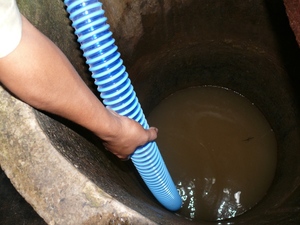 In order to prevent organic debris blown by the wind or any other debris from getting into the well, it must be closed. It is better to install a canopy roof that would reliably protect the well. In addition to the canopy, the well must be covered with a lid. The lid can be made of wood. It should not be too light so that the wind cannot lift it, but not heavy either, since it will simply be inconvenient to use the well.
In order to prevent organic debris blown by the wind or any other debris from getting into the well, it must be closed. It is better to install a canopy roof that would reliably protect the well. In addition to the canopy, the well must be covered with a lid. The lid can be made of wood. It should not be too light so that the wind cannot lift it, but not heavy either, since it will simply be inconvenient to use the well.
The well is constantly polluted, but this is not a reason to refuse clean drinking water.
Let's talk secrets...
Have you ever experienced joint pain? And you know firsthand what it is:
- inability to move comfortably and easily;
- pain during or after exercise;
- discomfort when going up and down stairs;
- inflammation in the joints, swelling;
- unpleasant crunch, clicking not of their own free will;
- causeless and unbearable aching pain in the joints ...
Please answer the question: are you satisfied with this? Can such pain be endured? How much money have you already "leaked" for ineffective treatment? Time to end this! Do you agree? Today we are publishing an exclusive interview with Professor Dikul, in which the doctor revealed the secrets of getting rid of joint pain, treating arthritis and arthrosis.
Attention, only TODAY!
Well cleaning pump - a thing in the owner's household country house With autonomous water supply irreplaceable. Wells are mine structures, for this reason they need regular cleaning. sewer wells- storage, drainage and filtration - these are varieties that are initially created so that accumulated sediments, silt and garbage can be systematically selected from them. Water supply wells become unusable over time, but they also have to be sanitized, flushed, and cleaned regularly.
We clean the well
Some gardeners perform cleaning work manually - with a brush and a bucket with a rope. However, it is reliably known and verified: cleaning the well with a drainage pump from silt is a more productive and convenient operation. In practice, both types of work are usually combined: first, the walls of the mine are peeled off, and then the water-bearing lens is freed from excessive mud deposits. Cleaning the well includes several technological transitions, so the first step is to solve the following tasks:
- briefly formulate the goals of each stage of work;
- make a list of what you need technical means and fixtures;
- draw up a sequence of operations
- form a procedure for their safe and effective implementation.
Causes

A well can become unusable for a number of reasons. Some of them are related to geology - the quality of soils, but many factors depend on the operating conditions of the hydraulic structure. When they fall on the mirror Sun rays, life begins to develop under it - flora (blue-green algae) and fauna (bacteria, microorganisms). If the well is equipped with a poor-quality clay lock or a depressurization of the shaft has occurred, then surface runoff seeps into the mine, which leads to cloudy water. IN aquifer feces from a nearby sewer or untreated water from a nearby swamp may enter. Littering with mechanical objects, silt, foliage also leads to disruption of the well.
The water becomes cloudy, turns green, its level decreases, the bottom of the underground reservoir rises - the source ceases to function. Depending on the type of pollution, you will have to choose a certain type of pumping equipment.
Approximate list of works
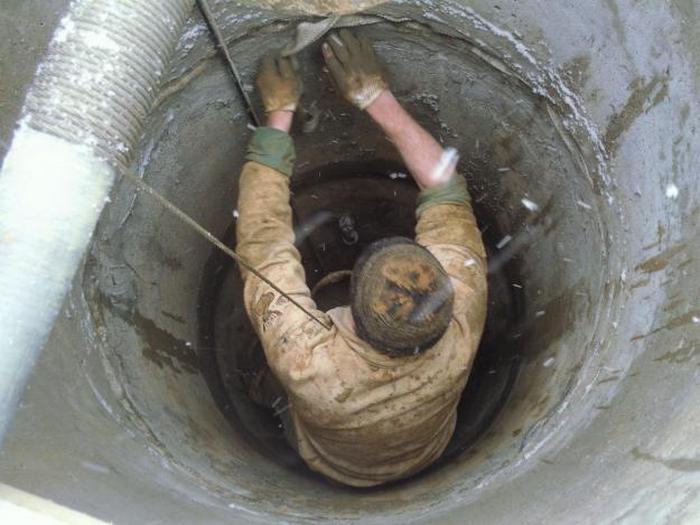
To clean the green walls of the above-water section of the mine shaft, to seal the mechanical damage to the rings, a pump is not needed. This will require a ladder, a steel bristle brush and appropriate Consumables. The processing of the underwater part of the walls and the cleaning of the bottom require the technical solution of several problems. Among them:
- pumping clean, continuously arriving water;
- pumping out bottom pulp with silt, gravel, sand, mule;
- discharge of purified water into the well;
- creating a pressure jet: with its help, you can clean the walls (knock neoplasms off them) and stir up bottom sediments, silt.
In the latter case, two pumps are needed. The first - bottom drainage - delivers an aqueous suspension, which contains sand and silt, to the filter tank. As such a device, a barrel with two valves filled with gravel is used. Strained water enters the intermediate reservoir, and from there - with the help of the "Brook" pump - it is fed through a hose under pressure to the bottom of the well. The worker operates a powerful jet in accordance with the task.
equipment requirements
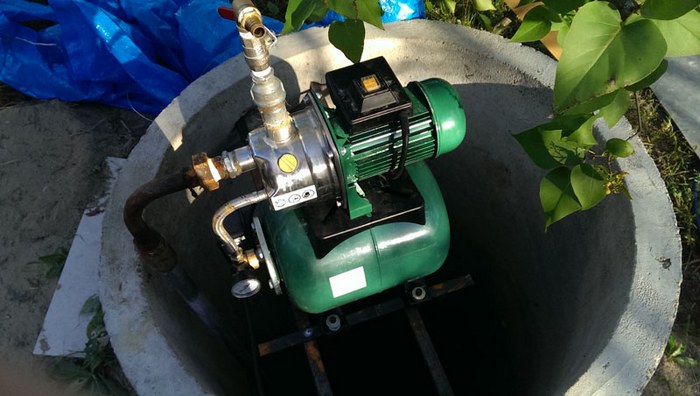
First of all, the choice of equipment is influenced by the degree and nature of water pollution. If water free from suspensions is collected in the well, you can get by with a budget model of a submersible or surface pump. However, when biological solids, sediment, sand, foreign objects - polymer bags, paper - are present in the water, it is better to use a specialized pump.
An important factor in the choice should be the type of equipment. Surface pumps are used to clean shallow wells. Their advantages include:
- ease of maintenance;
- relatively low cost;
- ease of installation and connection;
- high electrical safety.
The surface pump is located above the water, only the hose is immersed in the liquid. It can be used to drain any container, however, such equipment has a low power, the pump provides low pressure and is designed for shallow immersion depths - up to a maximum of 8-10 meters.
A conventional surface-type drainage pump is capable of lifting water from a depth of 4.5–6 m. The degree of water pollution should not exceed 10%, and the size of the fractions cannot be more than 1 mm.

Submersible pumps have more wide opportunities. They are made for domestic use- universal, but there are also specialized models. There are pumps:
- for pumping sandy water,
- chemically active liquids,
- faecal mixtures containing large inclusions, fibers, algae,
- drainage - for the removal of fresh or sea water with mechanical impurities of 5–50 mm,
- oil and others.
Various brands depending on the purpose have design features which increase their functionality and durability. If sand is present in the water, the pump impeller is made of cast iron. For pumping chemically active liquids, products with special materials for housings, seals, and electrical seals are used. All deep pumps provide powerful supply (from 12 to 300 cubic meters), high pressure (from 10 to 40 m).
Submersible pumps can be of rotary or vibratory action. IN rotary mechanisms impellers with blades are used to supply water. In vibrating - steel membranes. Under the influence of an electromagnet thin plate vibrates at twice the frequency alternating current. Part of the liquid that enters the working chamber under the action of elastic forces is pushed into the channel, where it is held by a rubber valve.
Vibratory pumps are low-power, but reliable and durable: there is no friction in them. For this reason, vibration pumps are used for pumping dirty water- the blades will not break in them due to their absence.
Rotary pumps can be equipped with float switches - devices that protect the engine from running dry and preventing it from overheating. There is a specific area for their application: pumping water from flooded sewer shafts, basements, trenches. When cleaning a well, additional automation is usually not needed: the source is not cleaned dry, and the raised water returns to the well.
The principle of operation of pumps

Drainage mud pumps are a single unit in which the engine and working mechanism are combined. An oil chamber and seals are installed between them. They are distinguished from ordinary submersible ones (with a multi-channel working part) by a single-channel wheel, which allows pumping liquids with mechanical inclusions.
The power of devices (in the domestic version) is 1.5–1.75 kW. With the help of drainage pumps, wells up to a depth of 60 m can be cleaned. The density of water should be 1.1–1.2 kgf / cm3, and the amount of impurities should be up to 10%. The size of suspended particles is limited by the filter mesh: in domestic products it is 5–10 mm, and in imported products it is up to 50 mm. The main feature of drainage pumps is the need for water cooling. For this, the environment is used.
Sand pumps - semi-submersible type are designed for pumping pulp with a density of 1.3-1.5 kgf / cm3. Work at a temperature not exceeding 60o. The flow part of these devices can be made of cast iron, corundum steel, rubber or ebonite.
Fecal pumps pump over liquids, the density of which does not exceed 1050 kg/cm3. But the presence in the water of fibrous formations, algae, rags and bottom flexible soft materials is not a problem. With the help of a special impeller, the mechanism cuts the inclusions into smaller fractions. These devices have wide inlet and outlet openings that allow the passage of sufficiently polluted water.
Pump markings
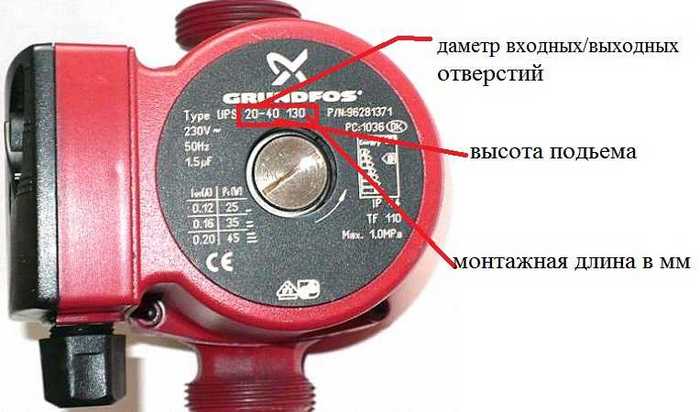
Pump markings different type from different manufacturers is not the same. You can find signs like this:
- The numerical index indicates the diameter of the inlet in mm divided by 25.
- Letter index- pump type. For example: K - console - one in which the working mechanism is placed on the shaft away from the engine. Next is the speed factor.
On drainage pumps manufactured by the Valdai plant, the following is affixed:
GNOM - single-stage monoblock mud pump. Numeric pairs indicate, respectively, the volume of supply and pressure. For example, 6-10 means: 6 cubes per hour for a height of 10 meters.
The abbreviation for the fecal pump includes groups of characters:
- SM - waste-mass,
- XX - the size of the inlet;
- XX is the size of the outlet.
Some models (for example, "Drainage") are marked in this way: XXX / X FN. It means:
- XXX - feed volume per minute, liters;
- X - water pressure, meters;
- F - fecal pump;
- H - stainless steel.
Other product labeling principles may be used, in which letter designations indicate the presence of automation, body and impeller materials, and other nuances.
Previously, work on cleaning the well bottom was carried out exclusively by hand using buckets and ropes. Now pumping equipment helps to cope with this problem. Most often, for these purposes, a powerful submersible or drainage pump is chosen for cleaning wells, capable of pumping water not only with sand, but even with small pebbles.
In the process of intensive operation of the well, silting of its bottom occurs, which leads to turbidity of water, a decrease in its flow, the appearance of bad smell. In order for the water source to always remain in a usable condition, it is necessary to periodically clean its bottom from washed sand, clay and other solid impurities.
It is recommended to clean the wells once every three years. With the exception of structures excavated on fine and silty sands, which require annual cleaning. Private hydraulic structures they are cleaned with the help of drainage pumps - devices endowed with great functionality.
Image Gallery
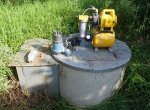
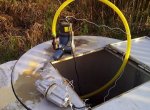
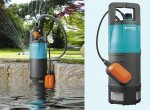
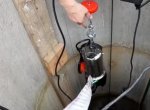
Drainage pumps are able to cope with the pumping of clean and turbid water from wells, flooded pits, pools, cellars, basements. The pump is also suitable for prompt removal unpleasant consequences utility accidents. In addition, the drainer can be used to ensure constant circulation of water in garden fountains, ponds and other artificial reservoirs.

Household drainage pumps can pump dirty water with solids up to 35 mm in diameter
In order to select the device that is optimal in terms of technical parameters, you need to clearly understand what kind of water, dirty or clean, pumping equipment will have to work with. By pure water it is customary to mean a liquid having inclusions with a size not exceeding 5 mm.
Drainage pumps designed for pumping clean and dirty water are distinguished by:
- outlet pipe diameter;
- diameter of the section of the suction hole;
- material taken for the manufacture of device parts.
Dirty water can contain solid particles up to 35 mm in cross section. Next, you need to determine the value of the total volume of pumped water. It is also important to know the depth from which it is supposed to organize the water intake, as well as take into account the composition of the bottom filter - what size gravel was used for its device.
In addition to cleaning wells, drainage pumps can drain flooded basements, stimulate water circulation in artificial reservoirs.
Pump selection by performance and pressure
In addition to water quality, the most important parameters for selecting a drainage pump include its performance and pressure. Productivity is understood as the volume of water that the pump is able to pump in a certain unit of time.
Typically, the performance of pumping equipment is measured in l / h or m3 / h, which respectively means liters per hour or Cubic Meters at one o'clock. The technical parameter shows how quickly the device will be able to clean the well from polluted water.
In order to choose a pump for cleaning the well, you need to know the depth of water intake and the composition of the bottom filter
Head is a measure of the height of water, measured in atmospheres, bars and meters. This indicator of drainage pumps is usually small, since water is pumped from a shallow depth. Do not forget about the ratio of vertical and horizontal pressure, which is 1:10.
For example, if you pump water from a well 8 m deep and move it 10 m along a hose lying on the ground to take it outside your site, then the pressure at the pump should be at least 9 meters. It is also necessary to remember that the pumps, depending on the height of the lift, will operate with different levels of performance.
Dependence graphs of both of these values can be found in the instructions that came with the device.
Types of submersible pumps
For pumping water, the owners of country houses land plots submersible pumps are used, which can be vibration or centrifugal. Models differ in the way water is sucked in, so the quality of the latter plays an important role when choosing pumping equipment.
The fact that water is pumped out in the well is signaled by a float, thanks to which the equipment does not run “dry”
Submersible centrifugal pumps
Models in which a wheel with blades is used as a suction device are called centrifugal. This feature design affects the increase in pump performance, and also prevents the ingress of abrasive particles in the pumped well water into it.
Water chambers and centrifugal wheels, depending on the model, can be manufactured:
- of steel;
- made of high quality polymer.
Also distinctive feature submersible drains is the presence in their design of a float or electronic switch. Float switch devices are more common because they are simpler, cheaper, and most importantly, more reliable. The switch is needed in order to automate the process of pumping water.
Some models of drainage pumps use a centrifugal mechanism. Before buying them, you should find out if the pump can pump abrasive particles.
A float switch is a small sealed container with a block of contacts inside. When the water level drops, the float drops, thereby turning off the engine, preventing it from running dry. Running "dry" leads to the failure of the pumping device. The body of the drain pump must always be immersed in liquid, as water helps to cool the working mechanism. Water also acts as a lubricant for rotating parts.
Installing a drain pump: step by step instructions
Before starting work to install the pump, a flat area is determined or arranged so that it functions in a strictly vertical position, then:
- A hose is connected to the pressure pipe, using connecting elements for fastening.
- If the model has a float switch, a check valve is installed on the pressure line.
- A device equipped with a three-phase electric motor must be checked for correct rotation of the centrifugal wheel.
- They turn on the equipment and immediately turn it off, paying attention to the direction of rotation of the pump shaft: clockwise - everything is connected correctly, if not, the phases are reversed.
- The pump is connected with a carabiner to the cable of the electric winch or to the rope, making sure that the discharge pipe remains directed upwards.
- The unit is slowly lowered to the bottom of the silty well.
- When operating pumping equipment, safety requirements are observed.
If there are signs of a malfunction in the equipment, you must immediately turn off the power supply and stop pumping.
Vibratory submersible pumps
Vibrating type pumping equipment works by changing the internal pressure, which causes the diaphragm to vibrate. The difference in pressure is due to the action magnetic field formed during the passage electric current through the coil.
Parts that are driven alternately under the influence of a magnetic field raise the water flow upwards. Vibration pumps are powered by a 220V power supply and consume approximately 270 W per hour (the figure depends on the power of the model).
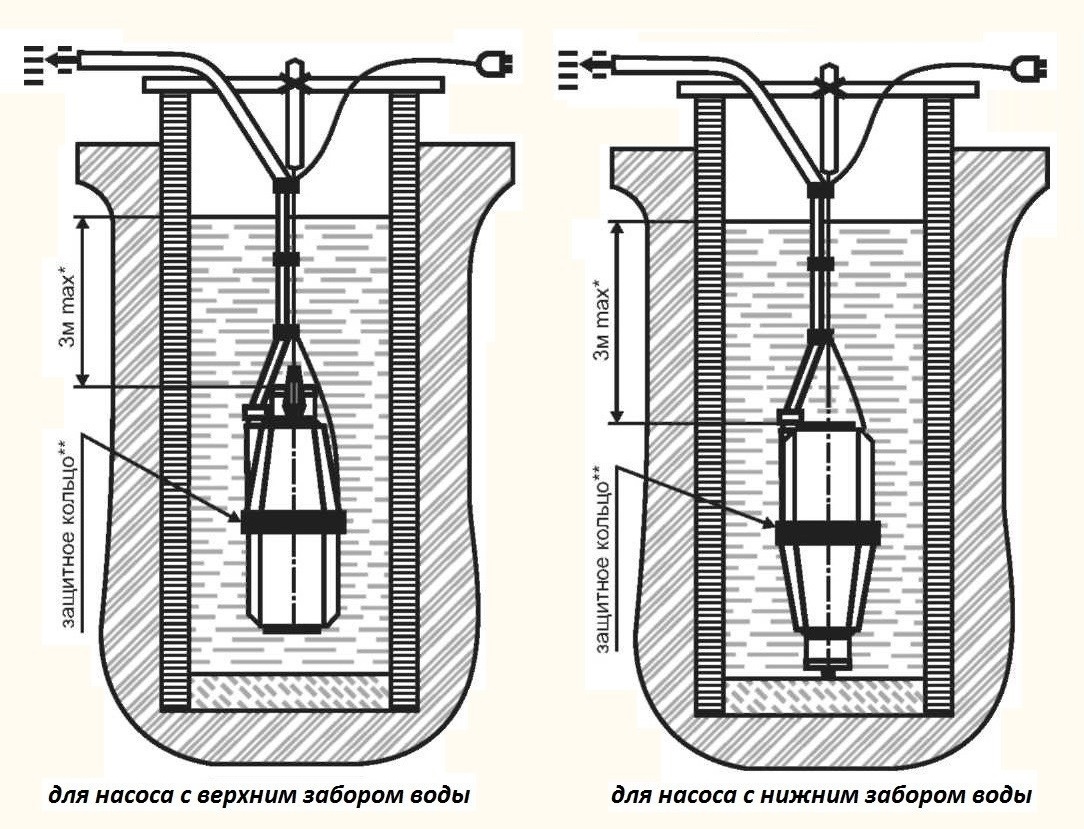
Vibratory pumps with upper and lower water intake are installed at different heights from the well bottom
Submersible vibration pumps can be produced with an upper or lower water intake from a well:
- Devices with an upper water intake function without overloads, as they do not heat up during operation due to the cooling of the entire system. Also, such pumps do not suck in the silt that has settled at the bottom of the well, and do not contribute to clouding of the water during the intake. Therefore, it is not advisable to use them for cleaning the well.
- Devices with lower suction of water, not equipped with automation and a thermal protection system, since the devices can overheat even during short-term operation “dry”. To protect the mechanisms from suction of sand and silt, a mechanical filter is used. Craftsmen replace the filter with an ordinary iron bucket in which the pump is placed. They lower the bucket with the apparatus into a low-debit well and pump water.
Vibration pumps are durable in operation, as there are no rotating elements and bearings in their design, and therefore the parts do not fail without being subjected to friction. When cleaning wells, vibration-type pumping equipment can only be used to pump out turbid water, and sand and silt can be scooped out manually with buckets, home-made scoops, buckets, grabs and other devices.
Image Gallery
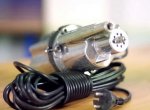
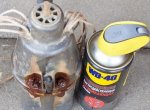


Selection of a hose for pumping water
Hoses or tubes for pumps must be selected depending on the pressure force, as well as on the diameter of the outlet section. The main requirement is that the diameter of the hose must match the diameter of the outlet. Compliance with this requirement will greatly extend the life of the purchased pump and will have a beneficial effect on its performance.
A fire hose can be used as a flexible hose, which is attached to the outlet pipe with a clamp. At the edge of the well ring, the sleeve is pinched, and the pump cannot push the pumped out water. Eliminate this problem allows plastic corner to which fire hoses are connected on both sides.
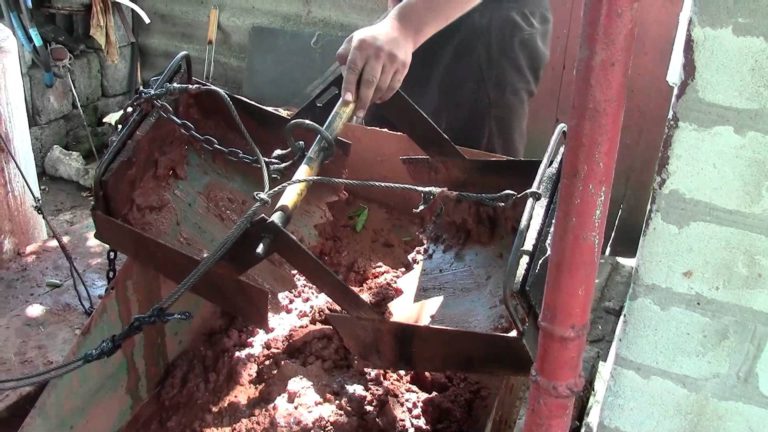
After pumping out dirty water from the well with a pump, the bottom sludge must be collected with a bucket and brought to the surface
Features of connecting submersible pumps
Before lowering the pump into the well, a number of preparatory measures are carried out, namely:
- determine the depth of the apparatus in the source;
- fix the hose on the nozzle using a plastic clamp;
- thread a nylon cord or a steel cable of small diameter into special lugs on the pump housing;
- a special rubber ring is pulled onto the body, which will protect the vibration pump from mechanical damage in case of contact with the concrete walls of the well shaft;
- elastic rubber 0.5 meters long is tied to the upper end of the cord so that it dampens vibrations.
A pump with a lower water intake is placed at a distance of 1.0 m from the bottom of the well, and with an upper one slightly lower - 0.5 m. The cable to which the pump is attached is fixed to the crossbar installed on the top well ring. After completing the installation of equipment, connect the pump to electricity.
If the length of the cord is not enough, then it is extended with an additional cable, while the connection must be outside the well shaft. During the pumping of water, its pressure is monitored, preventing the “dry” running of the motor. After two hours of continuous operation, turn off the pump for 15 minutes to avoid overheating of the motor.
Image Gallery


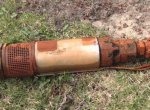
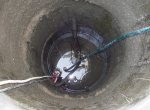
Cleaning a heavily silted well
With a strong silting of the well, the efficiency of using the drainage pump is sharply reduced. The equipment quickly becomes clogged with sand, and therefore does not cope with the tasks assigned to it. Some summer residents advise using in this case another surface pump, which, under pressure, discharges the water cleared of sand back into the well shaft, thereby contributing to the erosion of bottom sediments.
The method is as follows:
- a barrel or other container is installed near the well, the volume of which is 200-300 liters;
- a drainage pump is lowered into the well shaft, which pumps muddy water from the well into the prepared container;
- clean water that has settled in the barrel is sent back to the well by the second pump, and sand is removed from the bottom of the tank;
- a jet of water, launched under pressure, washes away the bottom sand, which, together with water, rises to the top of the barrel with a drainage pump, and everything is repeated anew.
This method of cleaning the well has opponents who consider it uneconomical. In their opinion, it is more profitable to hire a team of workers who are able to go down and scoop out the silt in buckets, raising it to the surface. If this is not possible, why not try the two-pump option.
Vibration pumps are used for pumping dirty water without solids.
Rules for operating the pump when cleaning the well
When choosing the right model for cleaning the well, carefully read the instructions. After all, some drainage pumps were originally designed for lifting and pumping only clean water containing no impurities. The manufacturer warns about this in the description of the technical characteristics of the equipment.
If such devices start pumping contaminated water, they will quickly fail. Remember that a silted well must be cleaned with a drainage pump that can handle the intake of contaminated fluid that contains impurities and even small fibers.
Overview of popular models
Models of Russian and foreign manufacturers are presented on the pumping equipment market. Every brand has its fans. Budget pumps Russian companies"Whirlwind" and "Baby" attract affordable price and good performance. German pumps of the brand Wilo Drain, Grundfos, Karcher, like the Japanese Makita, do not need advertising.
These devices have high performance and reliability throughout the life of the product. When buying pumping equipment, be sure to check the availability of all the components specified in the attached instructions.
Pay attention to the restrictions on use indicated by the manufacturer. Remember that the technical characteristics of different pump models can vary significantly, which also affects the way they are used.
Practical advice: when cleaning wells, the float is tied to a rope or to a cable on which the pump is attached in order to pump out water from the greatest possible depth. In this case, of course, the manufacturer's recommendations for the operation of the equipment are violated, but it is possible to free the well from water almost to the very bottom.
At the end of this video you will see how to use two submersible pump with upper and lower water intake for cleaning the well.
After watching this video, you will learn how to clean the well vibration pump, usually used only to lift clean water.
Drainage pumps are indispensable assistants in the garden and suburban area. These low-cost devices are easy to use, easy to install and the result of their application is effective. With the help of pumping equipment, a silted well is easily and quickly cleaned. After pumping muddy water the well is filled with crystal clear life-giving moisture and begins to delight its owners with delicious cold water.
In addition, the pump can always be used for other tasks. During floods and the rise of groundwater, flooded basements are quickly freed from gushing water. With such a pump, you can pump out the pond, clearing its bottom of silt accumulations. A diligent owner will always find a way to increase the coefficient useful action purchased equipment.








